يمكن أن يؤدي استخدام العجلات إلى تقليل القوى العاملة وزيادة كفاءة العمل. يجب اختيار العجلات الصحيحة من خلال طريقة التطبيق والشرط والطلب (على سبيل المثال المنشأة ، وإنقاذ القلة ، والمتانة).
يجب اعتبار العوامل على النحو التالي:
1. سعة تحميل اللاحقة
محسوبة على النحو التالي:

t = كل تحميل العجلات
ه = وزن السيارة
z = وزن كائن متحرك
M = كمية الكفاءة في الحمل (يجب النظر في الموضع والتوزيع الثقيل المختلفة).
هنا حاسبة تحميل العجلات، يمكنك إدخال القيمة مباشرة لحساب العجلات باستخدام سعة التحميل التي تحتاجها.
إذا كنت لا تعرف كيفية الحساب ، فيمكنك الاتصال بنا مباشرة للحصول على استشارة مجانية.
تتبع كمية الحمل الفعالة العجلات:


عند الاختيار ، يجب حسابه وفقًا لسعة تحمل العجلات في أقصى نقطة دعم.
يجب مراعاة حمل العجلات في موضع الحد الأقصى عند اختيار سعة التحميل. موضع الحمل الخرساني والحد الأقصى للموضع (P2) على النحو التالي:

2. سماكة قوس التثبيت على عجلة العجلات والمعالجة السطحية
سمك القوس
أولا ، النظر في وزن العجلات. مثل محلات السوبر ماركت والمدارس والمستشفيات والمباني المكتبية والفنادق والأماكن الأخرى ، لأن الأرضية جيدة وسلسة والبضائع التي يتم حملها خفيفة ، فهي مناسبة لاختيار إطار العجلة المطلي مختومة وتشكيلها بواسطة لوحة فولاذية رقيقة (2-- 2- 4 مم) ، إطار العجلة خفيف ومرن للعمل والهدوء والجميل ، ويتم تقسيم إطار العجلة الكهربائية هذا إلى كرات صف مزدوجة وكرات صف واحد وفقًا لترتيب الكرات ، إذا كنت تتحرك غالبًا أو تحمل صفًا مزدوجًا الكرات ، استخدم كرات الصفوف المزدوجة.
في أماكن مثل المصانع والمستودعات ، حيث يتم نقل البضائع بشكل متكرر والحمل ثقيل (يمكن أن يحمل كل عجلات 280-420 كجم) ، فهي مناسبة لاستخدام ألواح فولاذية سميكة (5-6 مم) مختومة ، ومزدوجة الساخنة ، واللحام مع رف عجلات الكرة المزدوجة.
إذا تم استخدامه لحمل كائنات ثقيلة مثل مصانع النسيج ، ومصانع السيارات ، ومصانع الآلات ، وما إلى ذلك ، بسبب الحمل الثقيل والمسافة الطويلة على الأقدام في المصنع (يتم تحميل كل عجلات في 350-1200 كجم) ، ألواح فولاذية سميكة ( يجب تحديد 8-12 مم)) إطار العجلات الملحوم بعد القطع ، ويستخدم إطار العجلة المنقولة محامل كرة مسطحة ومحامل كروية على اللوحة السفلية ، بحيث يمكن للعجلات تحمل أحمالًا ثقيلة وتدوير مرونة ومقاومة التأثيرات والوظائف الأخرى.
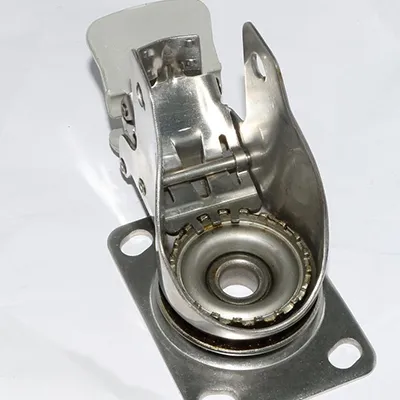
المعالجة السطحية
في السوق ، يتم تقسيم ألوان الأقواس الأكثر شيوعًا إلى نوعين: الفضة والأسود. يتم تحطيم اللون الفضي بالكهرباء ، ويتم مطلي طبقة من الزنك أو الكروم لجعل لون الفضة الفضية. الأسود مصنوعة بشكل عام من تقنية الكهربائي لجعل قوسينهم أسود. يعتمد نوع آخر من العجلات الراقية تقنية رش المسحوق ، ويمكن تخصيص اللون وفقًا لاحتياجات العملاء. بالطبع ، السعر مرتفع نسبيا. سواء كانت تقنية الطلاء الكهربائي ، أو تقنية الرحلة الكهربائية ، أو تقنية رش المسحوق ، فإن الغرض من ذلك هو منع سطح القوس من الصدأ.
3. أحجام عجلة العجلات
قطر عجلة العجلات له تأثير كبير على استخدامه. يوفر قطر العجلات الأكبر العديد من المزايا:
- تحسن التنقل: عجلات العجلات الكبيرة تتدحرج بسهولة أكبر على العقبات والأسطح غير المستوية والحطام. أنها توفر القدرة على المناورة أفضل وتتطلب بذل جهد أقل للدفع أو التوجيه ، مما يجعلها مناسبة للأحمال الثقيلة.
- سعة الوزن: عادة ما يكون للعجلات الكبيرة من العجلات قدرة على الوزن أعلى ، مما يسمح لهم بدعم الأحمال الأثقل دون المساس بالاستقرار.
- الحد من الضوضاء والاهتزاز: يمكن لعجلات العجلات الأكبر امتصاص الصدمات والاهتزازات بشكل أكثر فعالية ، مما يؤدي إلى ركوب أكثر سلاسة وأكثر هدوءًا ، وهو أمر ضروري في تطبيقات مثل المعدات الطبية والعربات الصناعية.
- المتانة: تميل عجلات العجلات الأكبر إلى أن تتمتع بعمر أطول لأنها توزع الوزن بشكل متساوٍ وتجربة أقل تآكلًا أثناء الاستخدام.
- الاستقرار: كلما كان قطر العجلات أكبر ، زاد استقرار الجهاز ، مما يقلل من خطر النقل أو فقدان التوازن.
كلما كان قطر العجلة أكبر ، كلما أصبح هناك المزيد من المنقذ ، يمكن أن يحمي سطح الأرضية تمامًا. تعمل العجلات الأكبر ببطء أكثر ، ولا يتم تسخينها وتشويهها بسهولة ، وأكثر متانة من العجلات الصغيرة. من الأفضل اختيار عجلة القطر الأكبر عندما يكون الارتفاع المناسب كافيًا.
4. سرعة حركة العجلات
طلب سرعة العجلات: في درجة الحرارة العادية وعلى الأرض السلسة ، يجب أن تكون السرعة أقل من 4 كم/ساعة من المشي ، وهناك فاصل ثابت أثناء وقت العمل.
إذا كنت بحاجة إلى استخدام العجلات ذات سرعات حركة أعلى ، فستحتاج إلى استخدام عجلات معينة ، مثل العجلات الهوائية.
5. بيئة استخدام العجلات وأنواع الأرضيات
أ. النظر في أنواع الأرضية: يتم استخدام العجلات بشكل عام على أرض مسطحة. إذا كانت الأرض غير متكافئة ، فيجب استخدام الكائنات الصلبة أو الإيداعات الحديدية ، في هذه الحالة ، عجلات أصعب ، مثل عجلات الحديد وعجلات النايلون.
ب. النظر في البيئة في الموقع: يتم استخدام عجلات البولي يوريثان بشكل عام للبيئة الخارجية أو الأرض مع الحمض والقلوي. في بيئة مع درجة حرارة 60 درجة أو أعلى ، عجلات عالية درجة الحرارة المقاومة أو العجلات الحديدية تستخدم عموما. في بيئة درجات الحرارة المنخفضة من 30 درجة ، فهي أكثر ملاءمة لاستخدام عجلات المطاط.
ج. النظر في البيئة المحيطة: بالنسبة للبيئات منخفضة الضوضاء ، يجب استخدام العجلات المصنوعة من البولي يوريثان الناعمة ، المرنة ، المطاط الاصطناعي ، ومواد أخرى ، مثل المكاتب والمستشفيات والأرضيات وورش العمل الهادئة وممرات النقل الكثيفة في مراكز التسوق.
6. اختر أنواع تصاعد العجلات المناسبة
ال طرق التثبيت يمكن أن تختلف العجلات بناءً على نوع الأثاث أو المعدات التي تقوم بربطها وتصميم العجلات المحددة. فيما يلي بعض طرق التثبيت الشائعة:

تصاعد لوحة
هذه هي الطريقة الأكثر شيوعًا لتثبيت العجلات. يحتوي العجلات على لوحة مسطحة مع ثقوب متزايدة ، وتربطها مباشرة بأسفل الأثاث أو المعدات باستخدام مسامير أو مسامير. تأكد من محاذاة الثقوب بشكل صحيح وربط العجلات بشكل آمن لضمان الاستقرار.
تصاعد الجذعية
بعض العجلات لها سيقان بدلا من اللوحات. يمكن إدراج هذه السيقان في ثقوب مسبقة في الأثاث أو المعدات. قد تحتاج إلى استخدام مقبس أو قوس لتأمين العجلات في مكانها.
تصاعد الجذعية الخيوط
على غرار تصاعد الجذعية ، يكون الجذع ملولب مثل المسمار. يمكن ثمل هذا النوع من العجلات مباشرة في فتحة ملولبة في الأثاث أو المعدات.
قبضة العنق الجذعية
تتضمن هذه الطريقة إدخال جذع العنق في قبضة العجلات في مأخذ أو شريحة مع أبعاد مطابقة. يمسك الجذعية في المقبس لعقد العجلات في مكانها.
توسيع محول تصاعد
يتم استخدام محولات توسيع العجلات مع سيقان العنق قبضة. أنها تتناسب مع أنابيب مستديرة أو أرجل الأثاث أو المعدات المجوفة ، وتتوسع في قبضة وعقد العجلات بشكل آمن.
تصاعد حلقة الاحتكاك
تنبع العجلات مع حلقات الاحتكاك على جذع يتم إدخاله في مأخذ أو قوس. يسمح حلقة الاحتكاك بالقرب من الجزء العلوي من الساق بتركيب دافئ وتثبيت آمن.
تصاعد دوار اللوحة العلوية
بالنسبة للعجلات الدوارة ، يتم استخدام صفيحة علوية مع سباق محمل للكرة للتركيب. تتيح هذه اللوحة للعجلة تدوير بحرية وتغيير الاتجاه بسهولة.
7. اختر مادة العجلات الصحيحة
تتوفر عجلات العجلات في مواد مختلفة ، ولكل منها مجموعة من خصائصها الفريدة مناسبة للتطبيقات المختلفة. تشمل بعض أنواع المواد الشائعة وخصائصها:
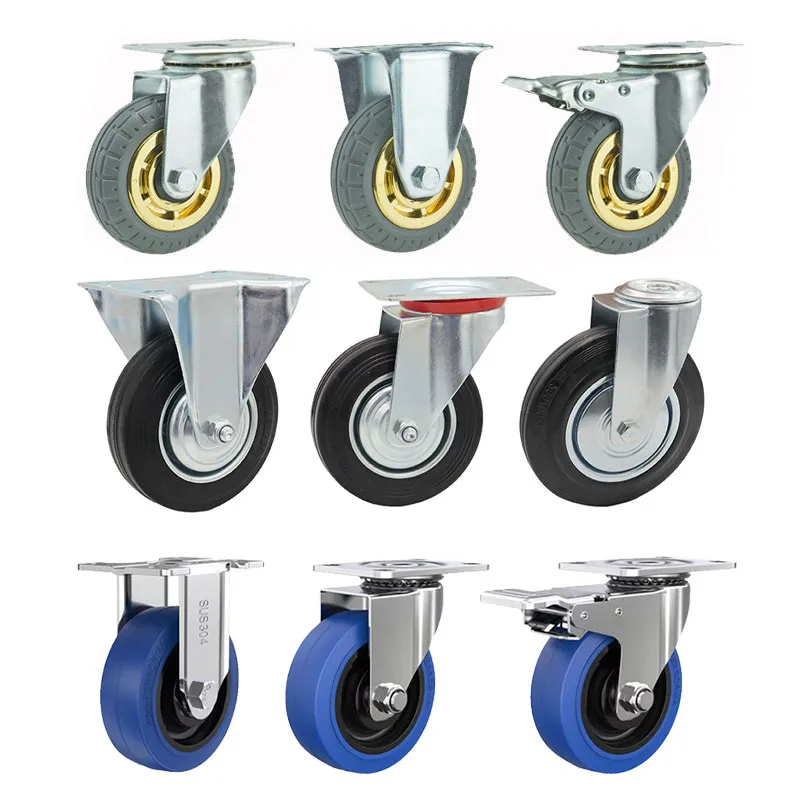
1. عجلة المطاط
تشتهر عجلات العجلات المطاطية بامتصاص الصدمات الممتاز وعملياتها الهادئة. أنها توفر جر جيد على الأسطح المختلفة ، مما يجعلها مناسبة للاستخدام الداخلي والأرضيات الحساسة. ومع ذلك ، فقد تلبس أسرع من المواد الأخرى عند استخدامها في الهواء الطلق أو على الأسطح الخشنة.
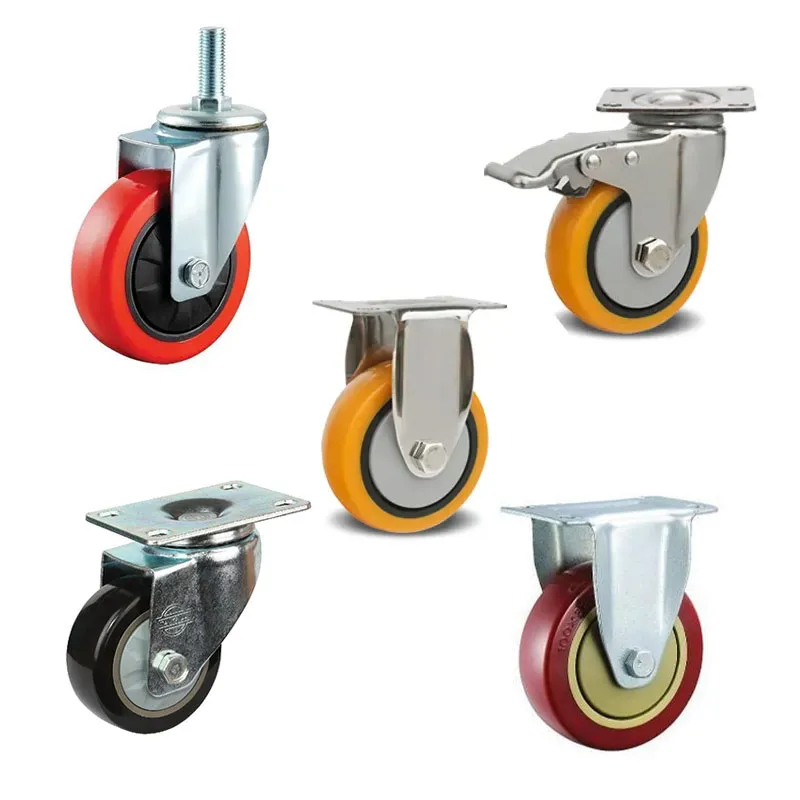
2. عجلة البولي يوريثان
توفر عجلات Polyurethane Caster قدرة فائقة الحمل ومقاومة للمواد الكيميائية والزيوت. فهي مناسبة للاستخدام الداخلي والخارجي ، مما يوفر توازنًا بين المتانة وحماية الأرضيات.
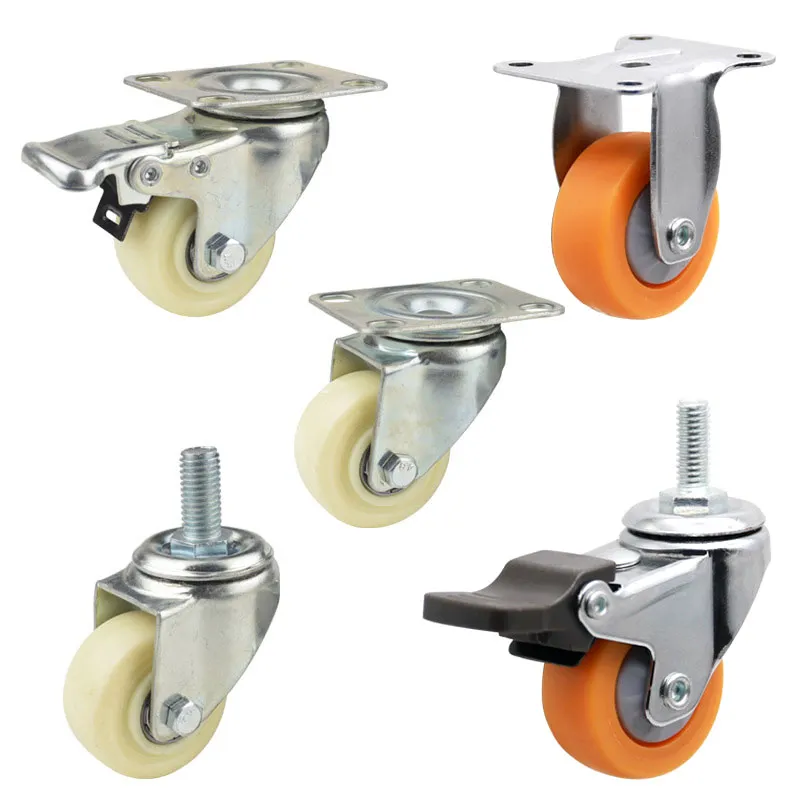
3. عجلة النايلون
عجلات النايلون عجلات خفيفة الوزن وقوية ومقاومة للغاية للتآكل. غالبًا ما يتم استخدامها في الإعدادات الصناعية ، والتعامل مع الأحمال الثقيلة ، وعلى الأسطح الخشنة. ومع ذلك ، فقد تسبب المزيد من الضرر للأرضيات الحساسة مقارنة بالمطاط أو البولي يوريثان.
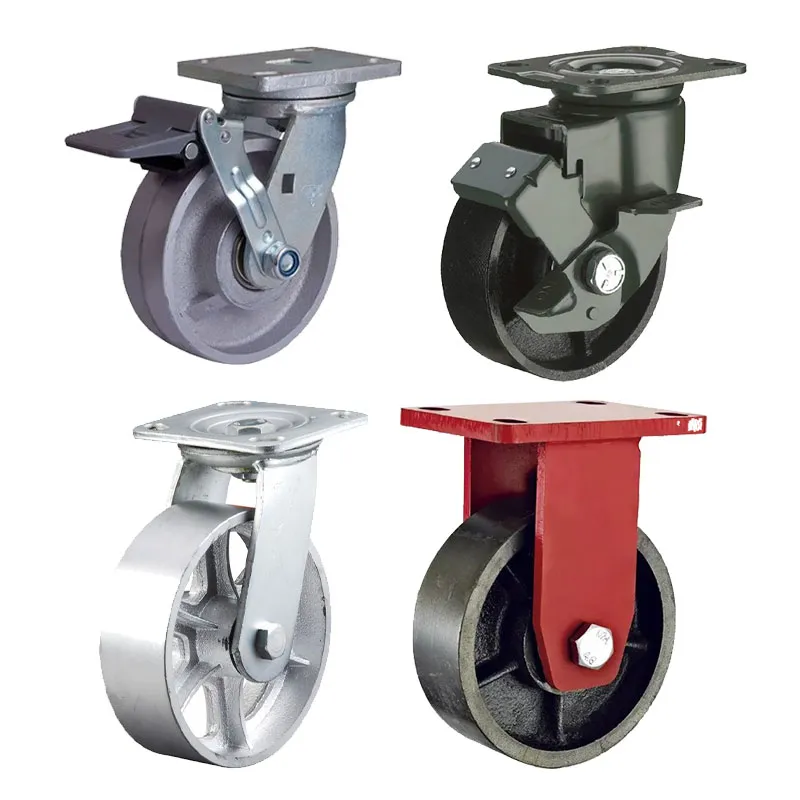
4. عجلة الحديد الزهر
عجلات العجلات الزهر متينة بشكل لا يصدق ويمكنها التعامل مع الأحمال الثقيلة للغاية. يتم استخدامها بشكل شائع في التطبيقات الصناعية والبيئات الخارجية ولكن يمكن أن تكون صاخبة وتسبب أضرارًا للأرضيات الحساسة.
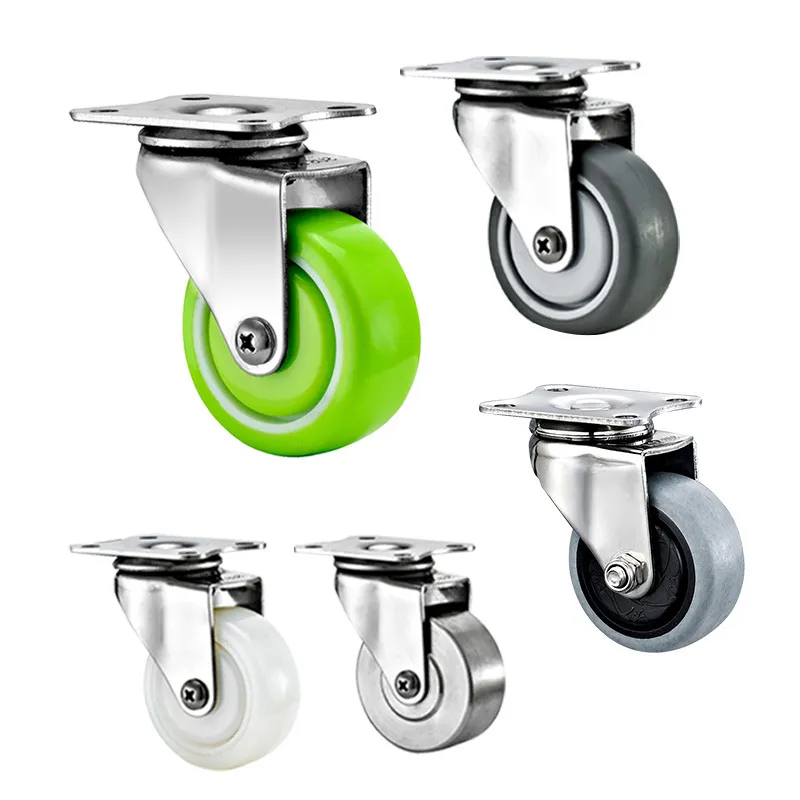
5. عجلة الفولاذ المقاوم للصدأ
توفر عجلات العجلات الفولاذ المقاوم للصدأ مقاومة ممتازة للتآكل ، مما يجعلها مثالية للاستخدام في معالجة الأغذية والصناعات الطبية والبحرية. إنها قوية ومناسبة لكل من التطبيقات الداخلية والخارجية.
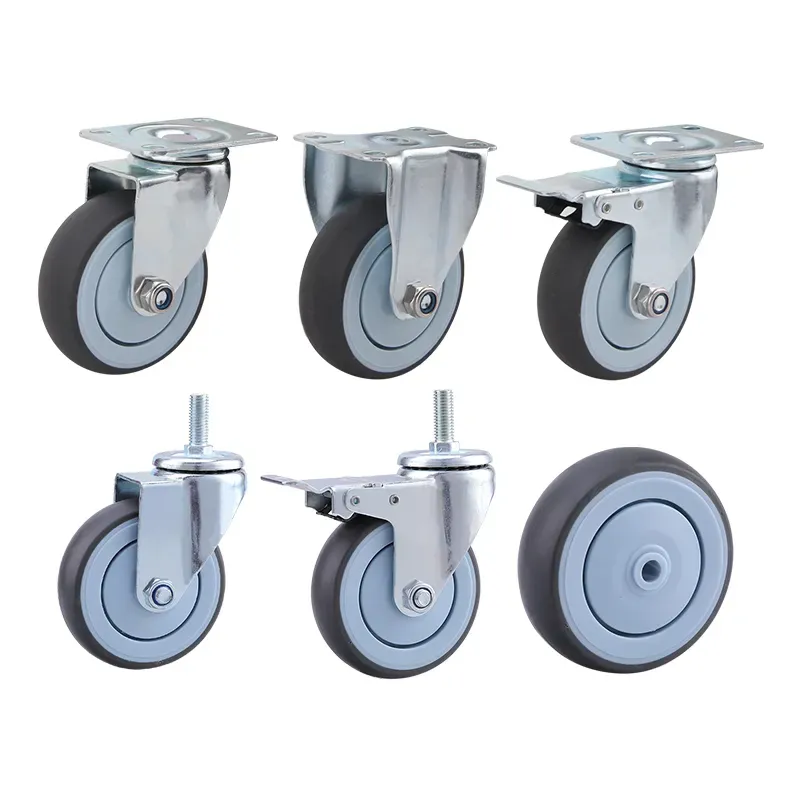
6. عجلة البلاستيك الحراري
عجلات العجلات الحرارية هي خفيفة الوزن ، غير علامات ، ومقاومة للمواد الكيميائية. يتم استخدامها بشكل شائع في إعدادات الرعاية الصحية والصناعات حيث تكون النظافة ضرورية.
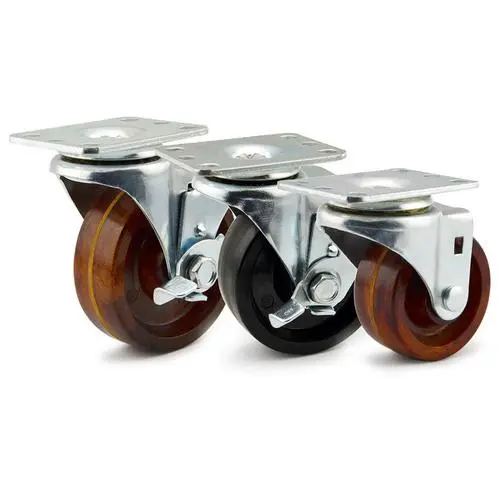
7. عجلة الفينول
عجلات العجلات الفينولية فعالة من حيث التكلفة وتوفر سعة تحميل جيدة. إنها تعمل بشكل جيد في البيئات الصناعية ولكنها قد لا تكون مناسبة للظروف الخارجية أو الرطبة.
عند اختيار مادة العجلات ، من الضروري التأكد من أن مادة العجلات تتطابق مع البيئة المستخدمة ، والتي يمكن أن تطيل عمر العجلات.
8. النظر في محامل العجلات
العجلات استخدام مختلف أنواع المحامل لتسهيل الحركة السلسة وتقليل الاحتكاك بين العجلة ولوحة التثبيت. فيما يلي خصائص بعض الأنواع الشائعة من محامل العجلات:
محمل كرة واحد:
تتكون كرة واحدة من كرة واحدة مغلقة في سباق السباق. يسمح هذا النوع من المحمل بالحركة الدورية الأساسية ، مما يوفر دوارة سلسة نسبيًا للتطبيقات الخفيفة إلى المتوسطة. ومع ذلك ، قد لا يتعامل مع الأحمال الثقيلة أو الأسطح الخشنة بشكل فعال مثل أنواع المحامل الأخرى.
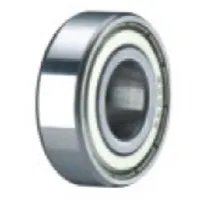
محمل الكرة المزدوج:
تحتوي محامل الكرة المزدوجة على مجموعتين من الكرات مفصولة بفاصل داخل السباق. يعزز هذا التصميم قدرة الحمل ويحسن الأداء العام للعجلات. توفر محامل الكرة المزدوجة دوارة أكثر سلاسة وهي مناسبة للأحمال الثقيلة والبيئات الأكثر تطلبًا.
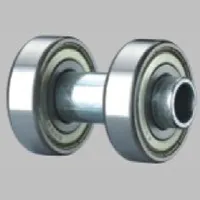
محمل الأسطوانة:
تستخدم محامل الأسطوانة بكرات أسطوانية بدلاً من الكرات ، موزعة على طول سباق السباق. توفر هذه المحامل سعة حمولة متزايدة وهي مناسبة تمامًا للتعامل مع الأحمال الثقيلة والأسطح الخشنة. أنها توفر مزيد من الدوران ويتم استخدامها بشكل شائع في صناعي والتطبيقات التجارية.
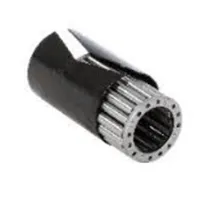
محامل مدببة (محامل تيرلينج):
تستخدم المحامل المدببة ، والمعروفة أيضًا باسم محامل terling ، بكرات مدببة للتعامل مع كل من الأحمال الشعاعية والمحورية. توفر هذه المحامل توزيعًا ممتازًا للحمل ، مما يجعلها مثالية لمواقف الحمل الشديدة والبيئات الوعرة. تم العثور عليها عادة في التطبيقات والمعدات الصناعية الشاقة.
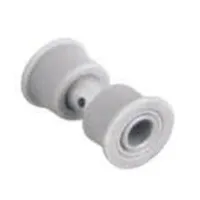
يعتمد اختيار نوع المحمل للعجلات على التطبيق المحدد ومتطلبات سعة التحميل والشروط التي سيتم استخدام العجلات فيها. توفر محامل الأسطوانة والمحامل المدببة إمكانات حاملة فائقة للحمل ، في حين أن محامل الكرة المزدوجة تجني توازنًا بين سعة الحمل وفعالية التكلفة. محامل كرة واحدة مناسبة للأحمال الأخف والسيناريوهات الأقل تطلبًا. تأكد دائمًا من أن نوع محمل العجلات المختار يطابق التطبيق المقصود لضمان الأداء الأمثل وطول العمر.
9. أنواع الفرامل العجلات
الفرامل الكاملة: الفرامل الكاملة هي طريقة فرامل شائعة العجلات ، مما يعني أنه عندما تكون العجلات في الحركة ، لا يمكن للعجلة تدوير ولا يمكن تدوير لوحة الدوران.
فرامل العجلة: يتم تثبيت فرامل واحدة في الأعلى ، مما يعني أنه عندما تتحرك العجلات ، تتوقف العجلة عن التحرك بعد التنقل على الفرامل ، ولكن لا يزال بإمكان القوس التدوير.
فرامل دوار: بعد التنقل على الفرامل ، تصبح العجلة العالمية عجلة اتجاهية.
الفرامل الجانبية: المكابح الجانبية للعجلة هي مكون ميكانيكي أو آلية يتم استخدامها لتثبيط أو قفل عجلة العجلات (عجلة دوارة غالباً ما توجد في الجزء السفلي من الأثاث ، والعربات ، وغيرها من الأشياء). عند الانخراط ، تمنع الفرامل الجانبية عجلة العجلات من الدوران وتبقي الكائن ثابتًا. طريقة الكبح هذه جميلة وآمنة ويمكن تشغيلها بسهولة مع قدميك.
لخص
Through this article, I believe you already have a basic understanding of choosing casters. By calculating the load requirements of casters and choosing the appropriate caster size, installation method, braking method, and wheel surface material, we can get the casters that best suit our needs.
If you want to know more information, please contact us directly, we can provide you with casters for medical, صناعي, أثاث, and other multi-purpose scenes.


